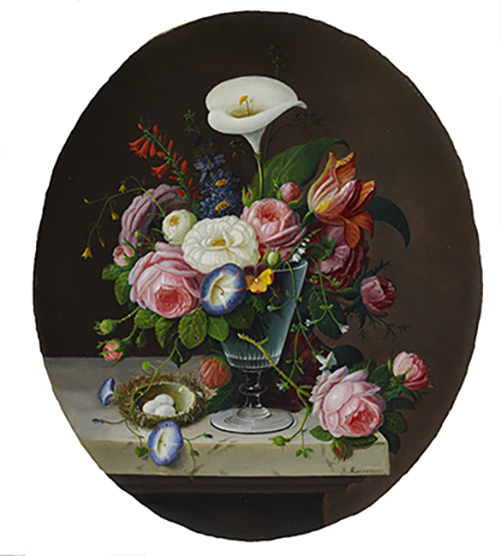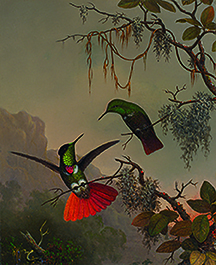I like art; most often, it’s a visceral connection. I enjoy being with art and experiencing it. I relish casual and informal “conversations” with artworks. I then imagine why a particular work “speaks” to me. Being curious by nature, though, I often also research works – learning to better appreciate the art. Research may include internet searches, tapping the collective wisdom of fellow curators, asking others in a gallery why they like the artwork, or asking an artist friend’s opinion. What results is a breezy, personal comment on art, reflecting the “eye of the beholder.”
One work in the Woodson Art Museum collection – Severin Roesen’s Flowers in a Crystal Vase, ca. 1859, is a personal favorite. I am often drawn to still lifes from this period. The moody, dark, heavy backgrounds highlighting the brilliantly lit foreground objects appeal to me. I suppose in this era of mindfulness, an interpretation of my interest could be that I strive to focus on what is nearest my sphere of influence and let the rest recede. Or maybe that the blooms I tend and raise shine, no matter the background. I prefer the latter.

Severin Roesen, Flowers in a Crystal Vase, ca. 1859
Physical proximity to this artwork – prominently on view in Collection Classics through August 9, 2020 – keeps it near in thought. However, it’s the supporting information that heightens my appreciation. Appreciation is relative.
Severin Roesen is considered to be an influential artist in the development of still life in later nineteenth-century American art.
The following is my loose interpretation of the history of still life in Europe and America, and Roesen’s penchant for still life, gleaned from the scant available biographical information: for generations, European academics considered the depiction of inanimate objects an inferior pursuit. Americans – particularly among those in an American invention, the middle class – however, embraced the subject matter. Perhaps the visual poeticism spoke to the American spirit: the harvest of plentiful fruits and flowers, split fruit with abundant seeds symbolizing new plantings, and the nest of eggs representing fertility or perhaps the Holy Trinity.
Escaping the political upheaval and economic crisis of 1848 Germany, Roesen likely chose these themes as a celebration of the prosperity and promise of his adopted country. Roesen wasn’t confined by a pursuit of authentic representation. Flowers and fruits that bloom and ripen at different times of the year are depicted in the same painting. Colors may be altered to create a more attractive composition – sacrificing botanical accuracy. I imagine he was more concerned with telling an aesthetically pleasing visual poem than a factual report.
Roesen – the man – left little in terms of a life story. Biographical information includes many “unknown” and “undocumented” references. A survey of his still lifes also reveals that he mixed-and-matched favorite elements: a pilsner glass, a dessert plate of strawberries, a wine goblet, and a nest of three eggs. I imagine he may have sought to capitalize on a product with a wide market.
Roesen – the artist – left much in terms of art. Art museums throughout America include his work. Visit the Woodson Art Museum, always admission free, and have an informal conversation with this and other artworks.
PS. The first still life that I purchased in poster form, featured Martin Johnson Heade’s Giant Magnolias on a Blue Velvet Cloth, at the National Gallery of Art. My modest poster has a great counterpart at the Woodson Art Museum – Two Hooded Visorbearer Hummingbirds, an original painting by Martin Johnson Heade, also on view in Collection Classics through August 9, 2020.

Martin Johnson Heade, Two Hooded Visorbearer Hummingbirds, ca. 1864-65




